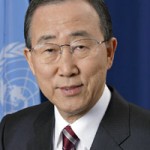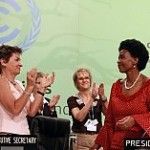Climate Diplomacy in plain language – glossary of key UN terms and their secret meaning
 This little glossary provides a short and critical guide to the main terms used in the context of the negotiations towards a climate agreement in 2015. Its main objective is not only to help the user navigate the climate discussions but also to read between the lines of country positions and understand the intent of negotiators invoking the terms including below.
This little glossary provides a short and critical guide to the main terms used in the context of the negotiations towards a climate agreement in 2015. Its main objective is not only to help the user navigate the climate discussions but also to read between the lines of country positions and understand the intent of negotiators invoking the terms including below.
If you feel like suggesting the inclusion of additional terms, please provide feedback in the comment section.
 2014 Summit of Leaders. UN Secretary General Ban Ki Moon has announced that he will organize a summit in 2014 to gather heads of states and of governments and raise the ambition of climate action. The summit will thus take place outside of the formal framework of the climate negotiations and is expected to provide additional impetus at the highest political level to boost the negotiations ahead of the conclusion of an agreement in 2015.
2014 Summit of Leaders. UN Secretary General Ban Ki Moon has announced that he will organize a summit in 2014 to gather heads of states and of governments and raise the ambition of climate action. The summit will thus take place outside of the formal framework of the climate negotiations and is expected to provide additional impetus at the highest political level to boost the negotiations ahead of the conclusion of an agreement in 2015.
Annexes. Annex 1 of the Convention lists 40 developed countries and the EU expected to take the lead in mitigating climate change. Annex 2 contains a more limited lists of the 23 countries (+EU) expected to provide financial and technological support to developing countries.
Article 4.7. The article 4.7 of the convention builds on the principle of common but differentiated responsibility as it conditions actions by developing countries to the effective delivery of financial and technological support by developed countries.
 Bali Road Map. The previous round of negotiations (2008-2012) took place under a mandate established during the 2007 Bali climate conference. In the context of the ongoing negotiations, some countries still refer to this mandate as the Bali Road Map suggested a strict differentiation between the mitigation actions adopted by developed (sometime referred as 1(b)1 on the basis of the numbering of the relevant paragraph) and developing countries (1(b)2), a distinction that the Durban Platform seems to take distance with.
Bali Road Map. The previous round of negotiations (2008-2012) took place under a mandate established during the 2007 Bali climate conference. In the context of the ongoing negotiations, some countries still refer to this mandate as the Bali Road Map suggested a strict differentiation between the mitigation actions adopted by developed (sometime referred as 1(b)1 on the basis of the numbering of the relevant paragraph) and developing countries (1(b)2), a distinction that the Durban Platform seems to take distance with.
Bottom-up. When building an international climate agreement, adopting a bottom-up approach consists in leaving the freedom for countries to come forward with whatever commitments they are willing to accept, compile them in a common document. This approach has the strong preference of the US and served as a basis for the US-inspired Copenhagen Accord. How national commitment will aggregate to match the level of ambition required to prevent dangerous human interference with the climate remains unanswered.
 CBDR (Common But Differentiated Responsibility). The notion of the common but differentiated responsibility of the international community for global environmental issues is a core principle of international environmental law since 1992. While its relevance to the climate negotiations is recognized by all (it is indeed explicitly recalled in the first articles of the convention), there is no formula on how to implement it in practice to allocate responsibility to different countries. While most actors generally agree that its implementation involves taking into consideration both historical responsibility and the current contribution to the climate crisis, interpretations differ regarding the relevant timeframe, the balance between both factors and other elements to possibly consider.
CBDR (Common But Differentiated Responsibility). The notion of the common but differentiated responsibility of the international community for global environmental issues is a core principle of international environmental law since 1992. While its relevance to the climate negotiations is recognized by all (it is indeed explicitly recalled in the first articles of the convention), there is no formula on how to implement it in practice to allocate responsibility to different countries. While most actors generally agree that its implementation involves taking into consideration both historical responsibility and the current contribution to the climate crisis, interpretations differ regarding the relevant timeframe, the balance between both factors and other elements to possibly consider.
CBDR-RC (Common but Differentiated Responsibility and Respective Capacity). Actors referring to the full quote of the principle mentioned in the convention (rather than its shorter version as included in other key international environmental texts) usually aim at emphasizing that the current economic and technological is an important aspect to take into consideration when allocating responsibility for climate action.
 Durban Platform. At the end of an epic and record-long final “night” of negotiations, countries agreed in 2011 to reset the climate negotiations and “launch a process to develop a protocol, another legal instrument or an agreed outcome with legal force under the Convention applicable to all Parties”. While the Durban Platform establishes the mandate for the new round of climate negotiations, it provides little indication on how the new agreement will be framed.
Durban Platform. At the end of an epic and record-long final “night” of negotiations, countries agreed in 2011 to reset the climate negotiations and “launch a process to develop a protocol, another legal instrument or an agreed outcome with legal force under the Convention applicable to all Parties”. While the Durban Platform establishes the mandate for the new round of climate negotiations, it provides little indication on how the new agreement will be framed.
Dynamic approach. Countries usually refer to the new to interpret the convention dynamically to highlight the need to downplay the role of the annexes and the importance to take into consideration the economic reality of the 21st century.
Firewall. Metaphor for the strong distinction between developed and developing countries’ commitment provided in the Bali Road Map on the basis of the annexes of the convention (see Bali Road Map and Annexes above).
 Mitigation gap. The concept of a mitigation gap is particularly important in the context of short-term mitigation action (see Workstream 2 below). The gap is measured between the national mitigation commitments registered either under the Kyoto Protocol (Australia and EU) or under the Cancun Agreements and the level of ambition that is considered as providing a reasonable chance to meet the objective of maintaining the increase of temperatures under two degrees. The UNEP currently estimates the gap as being 8-13 gigatons wide.
Mitigation gap. The concept of a mitigation gap is particularly important in the context of short-term mitigation action (see Workstream 2 below). The gap is measured between the national mitigation commitments registered either under the Kyoto Protocol (Australia and EU) or under the Cancun Agreements and the level of ambition that is considered as providing a reasonable chance to meet the objective of maintaining the increase of temperatures under two degrees. The UNEP currently estimates the gap as being 8-13 gigatons wide.
Outcome with a legal force. The compromise text adopted in Durban refers to the 2015 agreement being a protocol, a legal instrument or an “outcome with a legal force”. The latter term was included upon insistence of India who refused in 2011 the perspective of committing to an international treaty that would provide any kind of obligation for the country. Since then, lawyers have confirmed that the term could refer to legal implications under either international or domestic law – hence leaving the door open for an outcome with little international significance.
 Paris. Since the surprised announcement by French President of his willingness to host the 2015 climate conference, no over country has dared to enter into competition to host this prestigious event (and to take the political risk of a potential failure of the conference). The ongoing negotiations are thus expected to conclude with the adoption of a new global agreement in 2015 in Paris.
Paris. Since the surprised announcement by French President of his willingness to host the 2015 climate conference, no over country has dared to enter into competition to host this prestigious event (and to take the political risk of a potential failure of the conference). The ongoing negotiations are thus expected to conclude with the adoption of a new global agreement in 2015 in Paris.
 Package deal. Countries remind their partners of a particular discussion being part of a previous package deal when they feel that the main discussion on the table is providing a smoke screen to cover the lack of progress in parallel negotiations on issues attracting less hype but particularly important to them. In the context of the ADP, these issues might include scaling up of climate finance, progress on the establishment of a mechanism on loss and damage, negotiations to address the short-term mitigation ambition gap.
Package deal. Countries remind their partners of a particular discussion being part of a previous package deal when they feel that the main discussion on the table is providing a smoke screen to cover the lack of progress in parallel negotiations on issues attracting less hype but particularly important to them. In the context of the ADP, these issues might include scaling up of climate finance, progress on the establishment of a mechanism on loss and damage, negotiations to address the short-term mitigation ambition gap.
Ratchet mechanism. Considering the low levels of mitigation commitments at the moment, parties are discussing the opportunity to establish ratchet mechanisms that would provide an opportunity for them to increase their ambition at a later stage (if new technologies/economic conjuncture/increase of political support a higher degree of ambition). Such mechanisms would allow to avoid parties “locking in” the current low level of commitments.
Real-world ambition. Used mainly by the US, this term refers to emissions actually happening on the ground, independent from the legal commitment that the country might have adopted. This wording aims at highlighting the fact that some countries have seen their emissions going down even in the absence of economy-wide targets. It also emphasizes the risk of adopting “unrealistic” targets at the international level that would not be implemented effectively at the national level.
 Spectrum of commitment. Suggesting that obligations provided in the 2015 climate agreement should take the form of a spectrum of commitment is equivalent of reject the current black-and-white categorization of countries in mainly two categories and calling for a much more subtle differentiations of countries’ commitments.
Spectrum of commitment. Suggesting that obligations provided in the 2015 climate agreement should take the form of a spectrum of commitment is equivalent of reject the current black-and-white categorization of countries in mainly two categories and calling for a much more subtle differentiations of countries’ commitments.
Top-down. Proponents of a top-down approach to emission reductions often quote the Kyoto Protocol as an example to follow. It relies on the definition of the emission reductions of individual country through multilateral negotiations rather than leaving each country’s defines its own contribution to the global agreement.
Under the convention. Countries referring to the need to keep discussions “under the convention” and to not “reinvent the wheel” usually implies a rather black-and-white differentiation between the role of developed and developing countries (see Annexes, Article 4.7 and CBDR above).
Unilateral measures. Developing countries have time and again insisted on their absolute opposition to the adoption by developed countries of any trade related instruments to curb carbon emissions – referred as unilateral (trade) measures. The EU decision to adopt a levee on pollution generated by civil aviation created over the past year the most dispute row over international climate policy.
 Warsaw. The 2013 annual climate conference will take place in November in the Polish capital city. The conference will be presided by the Polish minister of the environment Marcin Korolec who has made himself name in opposing systematically proposals for European climate policies. Fun fact: the conference will be hosted in the national stadium.
Warsaw. The 2013 annual climate conference will take place in November in the Polish capital city. The conference will be presided by the Polish minister of the environment Marcin Korolec who has made himself name in opposing systematically proposals for European climate policies. Fun fact: the conference will be hosted in the national stadium.
Workstream 1. Last year in June, countries agreed to structure with two parallel discussions the negotiations taking place between then and 2015. The workstream 1 refers to all issues related to the future climate agreement (based on the para. 2-6 of the Durban Platform).
Worsktream 2. In parallel to negotiating the 2015 climate agreement, countries also agreed to discuss to enhance short-term mitigation ambition – including possible efforts by all parties – so as to close the mitigation gap (para. 7-8 of the Durban platform). This discussion is particularly important for most vulnerable countries as the 2015 agreement is expected to become “applicable” only after 2020, despite most organizations warning that actions need to be taken during the current decade in order to avoid most dangerous levels of human-induced climate change.




-
http://twitter.com/estrelitadelmar Stacey Wilenkin
-
Spaghetti
-
http://glossarissimo.wordpress.com/2013/05/02/en-climate-diplomacy-in-plain-language-glossary-of-key-un-terms-and-their-secret-meaning-sebastien-duyck/ (EN) – Climate Diplomacy in plain language: glossary of key UN terms and their secret meaning | Sébastien Duyck | Glossarissimo!
About the author
Sébastien Duyck
Passionate environmental advocate, PhD student (Human Rights and Environmental Governance). Following particularly UNFCCC, UNEP and Rio+20 processes





